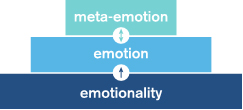Emotion, emotionality and meta-emotion
What does it mean to claim that emotion is the means, rather than the result of expression? Before explaining and justifying this claim, I must first briefly distinguish between some different theories of emotion in order to frame what is to come. The kind of emotion that I will be dealing with lies at the intersection of three concepts: firstly, in line with what Lisa Feldman Barrett has called the feeling tradition of emotion;1 secondly, involving what Katrin Pahl calls emotionality;2 and, thirdly, also including what Eva Maria Koopman calls meta-emotion.3
Barrett (et al.) observes three distinct traditions in the theories of emotion, and within those some fifteen discrete approaches. The three traditions she delineates are the feeling tradition (according to which emotions are subjective states); the motivational tradition (according to which emotions are tendencies toward certain behaviours); and the evaluative tradition (according to which emotions are fundamentally a matter of appraisal).4 The feeling tradition of emotion, according to Barrett, is a view that has been endorsed in various forms by Descartes, Hume, James, Lange, Damasio, and Barrett herself, among others. It holds, in a nutshell, that emotions are particular subjective feelings – particular quale of a distinctive type.5 On this view, it is sufficient to be experiencing an emotion that one has a particular subjective experience, which may trigger or coincide with physiological changes.6 When I refer to emotion per se, I will mean this subjective experience on the part of the reader.
The second term I employ is ‘emotionality’, borrowed from Katrin Pahl. Pahl suggests ‘emotionality’ is more appropriate than ‘emotion’ when analysing literary texts, as a way of avoiding a certain ‘taxonomic impulse’ (the term ‘emotion’, as Pahl rightly suggests, tends to conjure up a hierarchy of the most salient emotions, thus conceiving of them as stable and fixed, rather than fluid, dynamic and nuanced).7 Emotionality is used to refer to a specific phenomenon in literature, namely points of conflict or contradiction in emotional states, objects or language. Deliberately defining emotionality ‘as minimally as possible’ so as to allow its particulars to change over time, Pahl defines emotionality as ‘a transformational or jumbling force that puts things or people at odds with themselves.’ ‘A text is emotional’, she suggests, ‘when it is incongruous and (self-)transforming.’8 This term is useful because it allows us to locate and speak of emotion in the language of the text itself, rather than in the author or in the reader. I will use emotionality, then, when analysing at the level of language, and retain the word ‘emotion’ for use when examining feeling on the part of the reader.
The last term for use here is the concept of meta-emotion, borrowed from Eva Maria Koopman. As the name suggests, meta-emotion is simply emotion about emotion, such as a certain joy in one’s melancholy, a guilt in one’s pleasure or surprise in one’s happiness.9 Meta-emotion is thus a higher-order emotional response that necessarily entails appraisal, where regular emotion needn’t involve appraisal (as I am treating ‘emotion’ as subjective feeling). The best way to imagine these three aspects of emotion intersecting is as a tiered system, which we can roughly represent as follows:

Figure 1: The relationship between emotionality, emotion and meta-emotion.
At the base level of the text we have an abundance of emotionality, which is always in excess of any one reading (this is similar to what Adorno refers to as the language character of the text).10 This emotionality then gives rise to emotion as affective response in the reader; a particular feeling, supported by physiological changes. This response (and the conditions that evoke it) are then appraised, giving rise to meta-emotional responses which may be congruent with the emotional response or, more often in Stag’s Leap, contradictory and dialectical in nature. Armed with these helpful terms, we can now turn to a critical reading of the work itself, beginning with the issue of dialectical meta-emotion in Stag’s Leap, and returning later to the issue of emotion as the means versus the result of expression.
- Barrett et al., Handbook of Emotions / Edited by Lisa Feldman Barrett, Michael Lewis, Jeannette M. Haviland-Jones, 5. ↩
- Pahl, ‘The Logic of Emotionality.’ ↩
- Koopman, ‘Why Do We Read Sad Books? Eudaimonic Motives and Meta-emotions’. ↩
- Barrett et al., Handbook of Emotions, 5. ↩
- id. ↩
- On some views, such physiological changes are considered separate to the emotion, on others (such as in William James) the physiological changes constitute the emotion itself. For Eric Shouse, subjective experience is merely ‘feeling’, and only becomes emotion once it is made social: ‘Emotion,’ he writes, ‘is the projection/display of a feeling.’ This entails that ‘the display of emotion can be either genuine or feigned.’ But if there is no feeling underlying an emotion (i.e. the emotion is a ‘feigned’ projection), then it cannot be emotion at all (if emotion is indeed the projection/display of a feeling). For this reason I put aside Shouse’s concept of emotion as projection in favour of tying emotion directly to feeling itself. See Shouse, ‘Feeling, Emotion, Affect’. ↩
- Pahl, ‘The Logic of Emotionality’, 1457. ↩
- bid. ↩
- Koopman, ‘Why Do We Read Sad Books? Eudaimonic Motives and Meta-emotions’, 19. ↩
- According to Adorno, language-character is comprised of two aspects of the text: the excess of meaning over subjective intention and the dependence of meaning on form. See Jarvis, Adorno: A Critical Introduction / Simon Jarvis., 103. ↩













